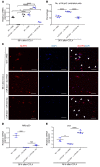Neutrophils contribute to spontaneous resolution of liver inflammation and fibrosis via microRNA-223
- PMID: 31295147
- PMCID: PMC6763256
- DOI: 10.1172/JCI122258
Neutrophils contribute to spontaneous resolution of liver inflammation and fibrosis via microRNA-223
Abstract
Persistent, unresolved inflammation in the liver represents a key trigger for hepatic injury and fibrosis in various liver diseases and is controlled by classically activated pro-inflammatory macrophages, while restorative macrophages of the liver are capable of reversing inflammation once the injury trigger ceases. Here we have identified a novel role for neutrophils as key contributors to resolving the inflammatory response in the liver. Using two models of liver inflammatory resolution, we found that mice undergoing neutrophil depletion during the resolution phase exhibited unresolved hepatic inflammation, activation of the fibrogenic machinery and early fibrosis. These findings were associated with an impairment of the phenotypic switch of pro-inflammatory macrophages into a restorative stage after removal of the cause of injury and an increased NLRP3 / miR-223 ratio. Mice with a deletion of the granulocyte specific miR-223 gene showed a similarly impaired resolution profile that could be reversed by restoring miR-223 levels using a miR-223 3p mimic or infusing neutrophils from wildtype animals. Collectively, our findings reveal a novel role for neutrophils in the liver as resolving effector cells that induce pro-inflammatory macrophages into a restorative phenotype, potentially via miR-223.
Keywords: Hepatology; Neutrophils.
Conflict of interest statement
Figures










Comment in
-
The Unexpected Role of Neutrophils for Resolving Liver Inflammation by Transmitting MicroRNA-223 to Macrophages.Hepatology. 2020 Feb;71(2):749-751. doi: 10.1002/hep.30925. Epub 2019 Dec 31. Hepatology. 2020. PMID: 31483871 No abstract available.
References
Publication types
MeSH terms
Substances
Grants and funding
LinkOut - more resources
Full Text Sources
Other Literature Sources
Medical

